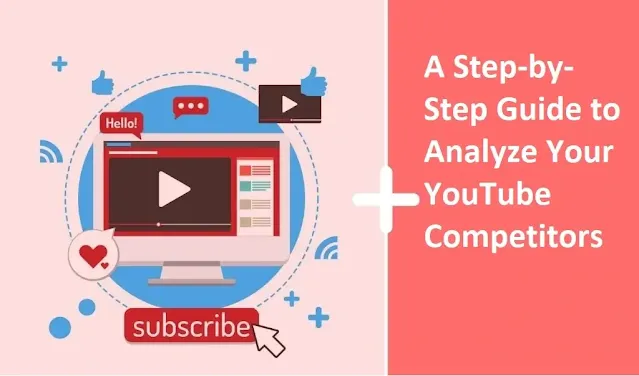YouTube is the largest and number one video content creator platform where millions of content creators create content to attract viewers to watch them online, but this is not an easy task because thousands of content creator in your niche doing the same. Performing competitor analysis on YouTube is essential to understand what works in your niche, identify opportunities. It will help you to improve your own channel's performance.
A Step-by-Step Guide to Analyze Your YouTube Competitors
Here's a step-by-step guide on how to Analyze Your YouTube Competitors:
1. Identify Your Competitors
The first step you must take to Identify your YouTube competitors. Competitors are channels that create similar content to your niche for same audience. This is essential step because it helps you narrow down your research focus. You will also learn from those who have already gained success within your niche.Also Read: How to Identify Your Competitors on YouTube
2. Analyze Their Content
Once you've identified your competitors, it's time to analyze their content. Watch their videos and pay close attention to their content strategy. What topics do they frequently cover? What types of videos do they create, such as tutorials, vlogs, reviews, or entertainment content? How often do they upload? By analyzing their content, you can uncover patterns and successful content formats.3. Assess Video Metrics
Video metrics such as views, likes, dislikes, comments and shares provide valuable insights into the performance of your competitors' videos. High engagement metrics, like the number of views, likes, dislikes, comments, and shares indicate that their content resonates with the audience. These indicators can help you to understand which videos are performing well and why and which can be crucial for your own content strategy.4. Study SEO and Titles
Optimizing videos for search engines is an important aspect of YouTube's success. Analyze your competitors' video titles, descriptions and tags. What keywords are they targeting? Look for common trends in their video titles and see how effectively they include relevant keywords. Additionally, consider the quality of their video thumbnails, as an eye-catching thumbnail can positively impact click-through rate (CTR).5. Audience Insights
It is important to understand your competitors' audience. Use YouTube Analytics to discover their audience demographics, such as age, gender and location. This information helps you customize your content to appeal to a similar audience. Additionally, note the level of engagement through comments and community interactions to increase audience interest.6. Social Media and Promotion
Social media one of the key factor to increase the audience retention. Many successful YouTubers increase their reach by sharing their content on other social media platforms like Instagram, Twitter, or Facebook. Investigate whether your competitors are active on these platforms and how they use them to promote their YouTube content. spying their promotional efforts can provide insight into expanding your own reach.Also Read: How to Link YouTube Channel with Facebook Fan Page
In summary, conducting a YouTube competitor analysis is a multi-faceted process that allows you to gain valuable insights from your competition. By thoroughly exploring and understanding your competitors, you can fine-tune your content strategy, improve your channel's performance, and ultimately thrive in the competitive world of YouTube content creation.
7. Content Schedule
Consistency is key on YouTube. Study your competitors' upload schedules and patterns. Do they publish videos at specific times or on particular days of the week? By doing this, you can plan for better engagement and get high growth by aligning with audience expectations.8. Identify Unique Selling Points (USPs)
It is very crucial to Identify what makes your competitors stand out. Every YouTube content creator has its own unique selling point (USP). These USPs may include a distinctive personality, exceptional production quality, specialized expertise, or a niche within your broader topic. You can differentiate yourself by recognizing these USPs and find opportunities to provide value that your competitors may not have.9. SWOT Analysis
A SWOT analysis (Strengths, Weaknesses, Opportunities, Threats) is a strategic assessment of each competitor. It involves recognizing their strengths and weaknesses, potential opportunities they are taking, and identifying the threats they face. You will get a clear picture by this analysis of where you can beat them and areas where you need to improve.10. Track Progress Over Time
Competitor analysis is not a one-time task, it's an ongoing process. Continuously monitor your competitors' channels and update your strategies as they evolve. Audience preferences change over time on YouTube, so staying updated ensures that your channel remains competitive and relevant in a dynamic environment.11. Implement Your Findings
The ultimate goal of competitor analysis is to apply your insights to enhance your YouTube channel. Implement changes based on what you've learned from your competitors. This could involve refining your content strategy, optimizing titles and descriptions, or improving audience engagement tactics. Iteration and adaptation are key to long-term success on YouTube.In summary, conducting a YouTube competitor analysis is a multi-faceted process that allows you to gain valuable insights from your competition. By thoroughly exploring and understanding your competitors, you can fine-tune your content strategy, improve your channel's performance, and ultimately thrive in the competitive world of YouTube content creation.

